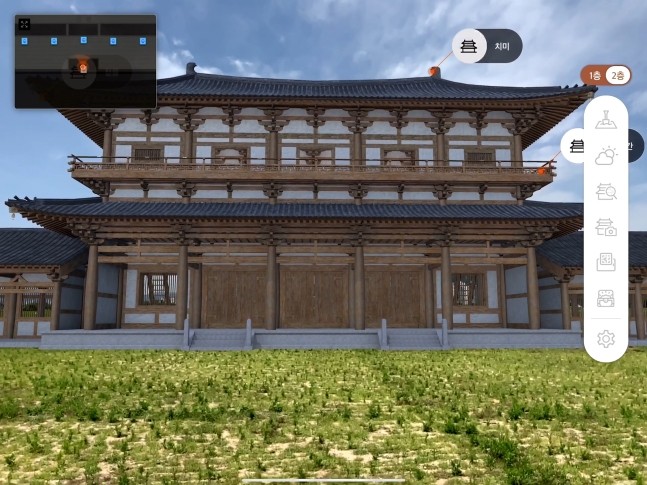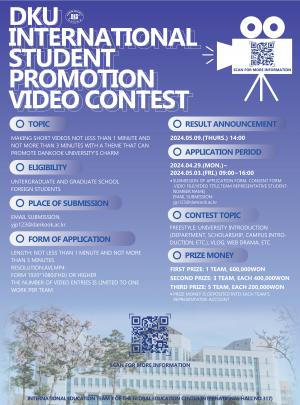On August 22, National Research Institute of Cultural Heritage Administration and Gyeongju-si said that part of Hwangnyongsa remaining only ground was reconstructed using Augmented Reality (AR) digital technology. It is one of the restoration work and maintenance business on key heritage of Silla. AR is a technology based on reality in contrast with Virtual Reality (VR) based on virtual worlds. After Hwangnyongsa was founded in 553, the 14th year of king Jinheung of Silla, it became the biggest temple in Silla accepting change over long periods. The Wooden pagoda on the ninth floor was constructed in 645, 14th year of the queen of Seonduck of Silla. It took 93 years for the whole structure to be completed from 553 to 645. However, Mongolia invaded Silla in 1238, the 25th year of the king of Gojong of Goryeo, and then Hwangnyongsa burned and left only ground called ‘Gyeongju Hwangnyongsaji’.
The reconstructed part of this time using digital technology with cultural heritage administration is the inner gate and the south corridor of Hwangnyongsa 1300 years ago in the period of united Silla. It is expected the biggest and the fanciest Hwangnyongsa. In the case of a foundation, it is estimated that it was one-story. But, in the case of the proportion of foundation and the whole construction, it might originally consist of two-story. So, restoration was proceeded in two different ways: a one-story building and a two-story building. The layout of the Hwangnyongsa is the inner gate, the wooden pagoda, the main building of the temple, and the hole on the north with the south gate. The size of the reconstructed inner gate is 26.4m X 12.6m and the size of the reconstructed south corridor is 272.5m in length including the inner gate. This inner gate and south corridor were completed from August 2019 to July 2020 improving the first product made from march to August 2018. Also, this digital restoration used camera location tracking technology, not a common Global Positioning System (GPS). It secured the positional accuracy to set up in the right place.
 |
| ▲ Hwangnyongsa Temple restored with augmented reality digital technology. (Photo from Seoul News) |
There is a case of digitally implementing cultural assets that do not exist, such as the restoration of Donuimun Gate. But this is the first time that they have implemented such cultural assets in real size. Although the existing digital restoration did not apply perspective, this restoration calculated the distance between people and buildings to maximize perspective. In addition, markers were installed in the middle to prevent the location of buildings from being moved when the buildings were constructed as augmented reality. And the real-time lighting technology was applied and the bake lighting technology was used to increase the sense of reality. As for data processing, the Level of Data (LOD) technology was used to enable smooth data processing for practical experience.
The cultural heritage administration is supposed to making the AR program with Gyeongju-si. It is a program that tourists visiting Hwangnyongsaji can experience entering the inner gate and south corridor personally using a tablet PC which is lent in Hwangnyongsaji. There are various programs like a treasure hunt game utilizing excavated artifacts, a view of ancient remains, experience in four seasons background, zooming in the buildings, and e-mail service and animation about the construction process. National research institute of cultural heritage is scheduled to restore the main building of Hwangnyongsa by 2024 and then the hall and the wooden pagoda to digital technology later.
Hwangnyongsa was burnt down in Silla dynasty due to Mongol invasion. Since then, we do not have any information on the construction of Hwangnyongsa temple, so it has remained as a site. Recently, however, it can be restored by using the AR program. Digital restoration is a technology that has recently been in the spotlight. Because it is easy to modify and supplement based on new research results and has low concerns over damage to cultural heritage sites. This restoration is meaningful in that it has a new definition of physical restoration.
정예지, 박소현 dankookherald@gmail.com

![[Campus Magnifier] Let's Surf the Library!](/news/photo/202404/12496_1765_4143.jpg) [Campus Magnifier] Let's Surf the Library!
[Campus Magnifier] Let's Surf the Library!
![[Campus Magnifier] Let's Surf the Library!](/news/thumbnail/202404/12496_1765_4143_v150.jpg)





